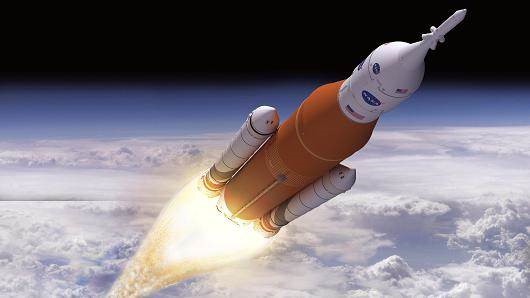Next Phase of Space Exploration About to Take Off
SpaceX completed another successful mission last week, launching 59 Starlink satellites, then safely landing its Falcon 9 solid rocket booster on a drone ship. Ho-hum.
These missions are so common now, it’s become easy to overlook the incredible technological accomplishment. It’s also easy to miss the impact reusable solid rocket boosters are having on the space economy.
It’s time for investors to get acquainted with some of the possible winners.
According to a November 2019 report compiled by CNBC, analysts at UBS Group AG (NYSE: UBS, Rated “C”), Morgan Stanley (NYSE: MS, Rated “C+”), The Goldman Sachs Group, Inc. (NYSE: GS, Rated “C-”) and Bank of America Corp. (NYSE: BAC, Rated “C”) believe space could be a multitrillion dollar opportunity during the next 10 to 20 years. That would be a giant step forward from the current $400 billion run rate.
The optimism is due to the potential for new markets.
When the space shuttle Columbia exploded on Feb. 1, 2003, NASA changed. Withering political confidence led to reduced funding. The federal agency that put a man on the moon was forced to nurture relationships with innovative commercial partners.
Related post: Space Is the Next Frontier for Investors
SpaceX, founded by Elon Musk in 2002, was the direct beneficiary of that shakeup.
The Hawthorne, Calif.-based company reimagined rocketry. Its reusable solid rocket boosters changed the economics of space. The cost to deliver a single kilogram to the cosmos under the space shuttle program was $54,500. Reusable gear from SpaceX, according to The Conversation, reduced that expense to only $2,720.
This new math opens up lots of new business models.

One of the most prominent business models, which was previously never thought economically feasible, is known as Starlink.
It’s a really big idea to deliver high-speed internet access to the entire world. The project would blanket the planet with a constellation of 12,000 low Earth orbit communication satellites.
However, SpaceX certainly will not have this market to themselves.
Last April, CNBC reported that Amazon.com, Inc. (Nasdaq: AMZN, Rated “C”) began working on Kuiper, a competing constellation of 3,236 LEO satellites. This follows a 2018 announcement to build AWS Ground Station, a network of 12 ground stations to transmit data to and from space.
The new economics of satellites is breathing life into the communications businesses of legacy aerospace firms, too.
In addition to their defense contracting businesses, Teledyne Technologies Incorporated (NYSE: TDY, Rated “B-”) and Lockheed Martin Corp. (NYSE: LMT, Rated “B-”) have significant exposure to extraterrestrial communications. In 2017, Northrop Grumman Corp. (NYSE: NOC, Rated “C+”) spent $9.2 billion to acquire Orbital ATK, a maker of launch vehicles and satellite systems. And L3Harris Technologies, Inc. (NYSE: LHX, Rated “C+”) builds components to make satellite data actionable for the military.
And aside from the main players in the legacy aerospace firms, there’s even more competition from outsiders.
Maxar Technologies, Inc. (NYSE: MAXR, Rated “C”) may be a small fry comparted to big aerospace firms, but the Colorado company is on the cutting edge of space imagery and data analytics. The company operates a constellation of geospatial satellites that managers claim is the evolution of GPS. Their tech helps application developers understand where things are in the world and where they are moving to.
Meanwhile, many companies are still working through the heavy lifting of traditional aerospace. They are still building infrastructure to get machinery and supplies to space.
Related post: Space Exploration Will Be Rocket Fuel for Investors

For example, The Boeing Company (NYSE: BA, Rated “D”) is building the Space Launch System, the most powerful rocket ever conceived. If all goes according to plan, SLS will carry astronauts to the moon and possibly even Mars. Space News reports that the first SLS launch is expected in the second half of 2021.
Components companies like Raytheon Technologies Corp. (NYSE: RTX, Rated “D+”) are helping build spacecraft for crewed missions, space suits and momentum and reaction wheels, which are cooling devices used to control the altitude of a space vessel without rockets.
HEICO Corp. (NYSE: HEI, Rated “C+”) and TransDigm Group Inc. (NYSE: TDG, Rated “C”) make mission critical specialty electronics and specially engineered parts. Often, these firms are the sole supplier of such items, resulting in extremely high profit margins. As the sector expands, sales momentum is also certain to grow.
Aerojet Rocketdyne Holdings, Inc. (NYSE: AJRD, Rated “C+”) operates in a similar capacity. Since 1945, the California company has been involved in the design and manufacture of aerospace and defense components. The company has helped power 1,600 rocket launches and is a major contractor to NASA, the U.S. government and leading aerospace companies like Boeing.
Rocketdyne and Boeing are also vital to space tourism, another new space business model. Last year, Virgin Galactic Holdings (NYSE: SPCE, Rated “D”) became the first public company in the sector, following a merger with Social Capital Hedosophia. The company received 400 refundable deposits and 7,957 online reservations to transport space travelers as soon as 2021, according to an Investor’s Business Daily post.
The SpaceX mission last week featured a $22 million solid rocket booster that had been used five times previously. Five years ago, the 160-foot-tall projectile would have ended up at the bottom of the Atlantic Ocean. Instead, it gently landed on an autonomous drone skip floating 350 nautical miles off the coast of The engineering is extreme, yet so routine that we take it all for granted.
The innovation has pushed the industry to an inflection point. Businesses that were impossible less than 10 years ago are suddenly viable. New business models and end markets are coming.
Savvy investors should look for weaknesses to get in on some of these positions. The future is here.
Best wishes,
Jon D. Markman



